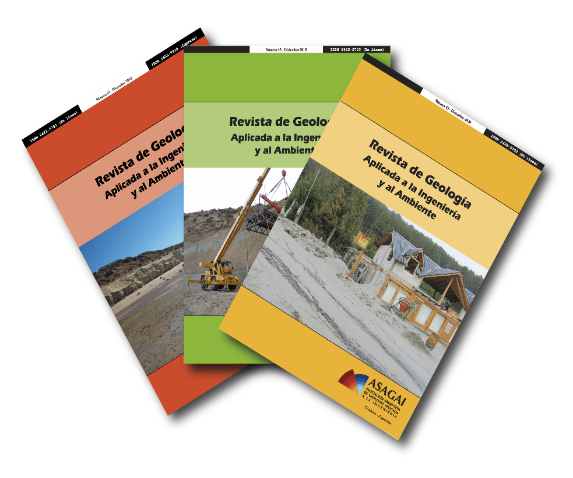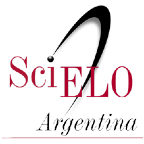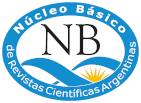Journal Statute
STATUTE of the Journal of Geology Applied to Engineering and the Environment
Preamble
The Journal of Geology Applied to Engineering and the Environment is the publication of the Argentine Association of Applied Geology to Engineering (ASAGAI), a non-profit civil entity established on December 29, 1975. The Association is the Argentine national group of the International Association for Engineering Geology and the Environment (IAEG).
Geology Applied to Engineering is defined, in the IAEG statutes, as “the science dedicated to the investigation, study and solution of environmental and engineering problems that correspond as a result of the interaction between geology and the works and activities of the human being, as well as the prediction and development of anticipatory measures or correction of geological hazards”.
The journal is a scientific periodical publication that has been published semi-annually in print format since 1998 (ISSN 1851-7838) and has been published in online format since 2008 (e- ISSN 2422-5703). Since 2023, it has updated its format to continuous publication.
The purpose of the Journal of Geology Applied to Engineering and the Environment is to promote the publication and dissemination of quality original articles in all its own areas, technical notes, book reviews, technical discussions, as well as the dissemination of news about events and publications of interest on the subject. It is aimed at scientists and professional geologists, engineers and technologists.
Management Bodies
The management bodies in charge of the scientific coordination and the edition of the journal will be the Editor-in-Chief, the Associate Editor and the Editorial Committee. As a general condition, it is established that all the specialists that make up these hierarchies will commit to adhere to and respect the international standards of Conduct and Good Practices published by the journal of Geology Applied to Engineering and the Environment.
a) Editor-in-Chief
The Editor-in-Chief constitutes the highest authority of the Journal of Geology Applied to Engineering and the Environment.
The functions of the Editor-in-Chief are: to exercise the legal representation of the journal, to promote its continuity, to take the appropriate measures to guarantee its publication, to negotiate with the Argentine Association of Geology Applied to Engineering the annual budget for the operation of the magazine, know the annual management report and the memory with the statistical summary of the most relevant data, ensure the recognition and conservation of the maximum scientific quality of the magazine before national and international rating agencies and indexes, inform the Argentine Association of Geology Applied to Engineering on the functioning and needs of the journal, proposing new members to fulfill the functions of Editorial Committee, Associate Editor and Evaluation Committee, verifying that the regulations referring to publication are met, applying criteria of objectivity and supervising the work of the rest of the members of the magazine, in any of its functions ions.
The Editor-in-Chief may be replaced (in case of not being able to continue with his/her duties by his/her own decision or due to force majeure) by an Associate Editor, who will ensure the continuity of the journal in his/her absence. The designation of the replacement (temporary or permanent) must be agreed upon by the entire editorial team (Associate Editors, members of the Editorial Committee and Editorial Secretary).
b) Associate Editor (s)
The Associate Editor is a collaborating member in the tasks carried out by the Editor in Chief. The Editor-in-Chief and Associate Editor(s) of the Journal of Geology Applied to Engineering and Environment are responsible for decisions on the articles submitted to the journal for publication. To do this, they must be guided by the publication policies established in this Statute and assume the legal requirements regarding the safeguarding of the quality of the publication, copyright and actions against plagiarism. The Editor-in-Chief and Associate Editor may share their decisions with other members of the journal's editorial team. Its functions are to enter the articles, determine the thematic relevance of the same that are received prior to sending them for review, verify that they comply with the guidelines for authors and establish the order in which the accepted articles will be published in each number, according to the magazine publication schedule.
The Associate Editor collaborates with the Editor-in-Chief and the Secretary of the Editorial Committee in joint tasks such as keeping the online editing system updated, proposing changes to the rules for authors when deemed necessary, promoting the dissemination of the journal in different areas academics and professionals in order to receive new articles and expand the visualization of the journal, promote and/or propose the generation of special issues of a specific theme when deemed appropriate, attend editorial team meetings when called by the Editor in Chief (or whoever replaces him), ensure the ethical aspects of the publication and develop research related to the improvement of the journal (for example, search for new indexing).
It also corresponds to the functions of the Associate Editor: to act as the designated editor for the online management of the articles entered into the system, to propose and assign reviewers for the articles according to the relevance and experience of each reviewer, to send the authors the result of the arbitration of their work, propose improvements to the authors in their originals so that they meet the publication requirements.
c) Editorial Committee
The Editorial Committee is made up of a group of national and international professionals who are related to the journal's field of knowledge. It is established that at least two thirds of the members of the Editorial Committee must be external to the Argentine Association of Geology Applied to Engineering. The members of the Editorial Committee will be people with experience in their field of knowledge, with accredited competence and recognized prestige for their scientific, applied or academic work, preferably with validity in their activity during the performance of their duties within the Committee.
The functions of the members of the Editorial Committee are: to collaborate with the Editors in the definition of the scientific guidelines for the publication of the journal and the institutional and academic support for it, to guarantee the scientific rigor and quality of the publications, to propose modifications in the editorial policy that allows the journal to be improved, review or propose internal or external reviewers for the articles whose relevance corresponds to them, advise the Editors on the criteria and objectives of the journal, identify and propose topics of interest that may be the axis for issues promotion of the magazine in different academic and professional fields in order to collect new articles and expand the visualization of the magazine and attend meetings of the editorial team when they are called by the Editor-in-Chief (or whoever replaces him) . It is also the responsibility of the members of the Editorial Committee to collaborate with their experience and support in the recognition, dissemination and consolidation of the journal in the academic, scientific and applied field of geology both in Argentina and abroad.
The Editor-in-Chief may request the advice of any member(s) of the Editorial Committee when he deems it necessary with regard to the entry of new manuscripts, reviewers and/or editorial decisions. The Editor-in-Chief, jointly or not with the Associate Editor(s) and the Editorial Secretary, may propose new members to integrate the Editorial Committee, basing his proposal based on the editorial needs and/or expertise of the candidate, in as for such incorporation to improve the magazine and the editorial process.
In the event that any member of the Editorial Committee is unable to fulfill their duties, whether due to force majeure or resignation, the Editor-in-Chief, together or not with the Associate Editor(s), may propose new members for Integrate the editorial team.
c) Editorial Committee Secretary
It is responsible for collaborating with the members of the Editorial Committee and the Editors in Chief and Associates in the tasks related to the reception, custody, and management of the original manuscripts for their evaluation and publication, attending to the institutional management of the journal, maintaining contact with other publications, as well as promoting the dissemination of the magazine in different academic fields.
The functions of the Secretary are to maintain a fluid exchange with the Editors to keep the journal updated in all its editorial aspects to guarantee its quality and manage new indexing in databases that allows the journal to be positioned in high publication standards.
The Secretary may suggest to the Editors modifications within the editorial process, guidelines for authors and the format of the online publication that tend to improve the visualization of the journal in its digital format and/or increase the dynamics of the editorial flow. The Secretary's functions are also to keep updated the affiliation and contact data of those who are part of the editorial team, to keep updated all the information regarding the journal and its editorial policies, to manage new users who enter the editorial system (whether as authors, reviewers and/or editors), advising new users regarding queries that may arise during the submission of new manuscripts at any of the stages of the editorial process.
Characteristics of the Journal
General considerations
The Journal of Geology Applied to Engineering and the Environment will have continuos publication (a number per year). Other extraordinary issues may be published depending on the availability of funding and the number of relevant articles. The reception of articles is permanently open.
Original and guest articles, book reviews, technical notes and discussions, as well as news pertinent to the journal or the Publisher Association will be included. Manuscripts must conform to the guidelines for authors published by the journal.
All information relevant to the operation of the journal and the editorial process must be included and visible to the public on the journal's website.
Language
The journal will admit articles in Spanish, English and Portuguese, as detailed in the rules for authors published by it.
Open Access Policy
This journal provides open access to its content.









